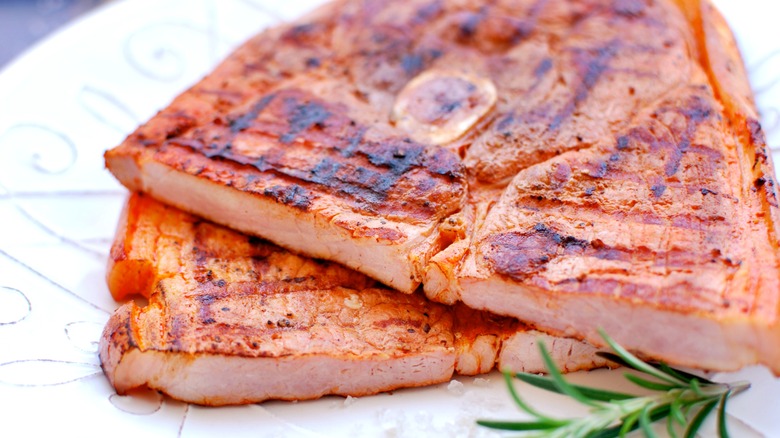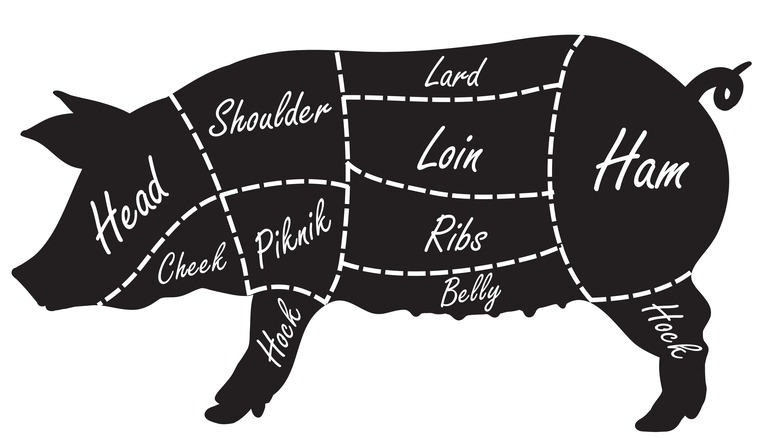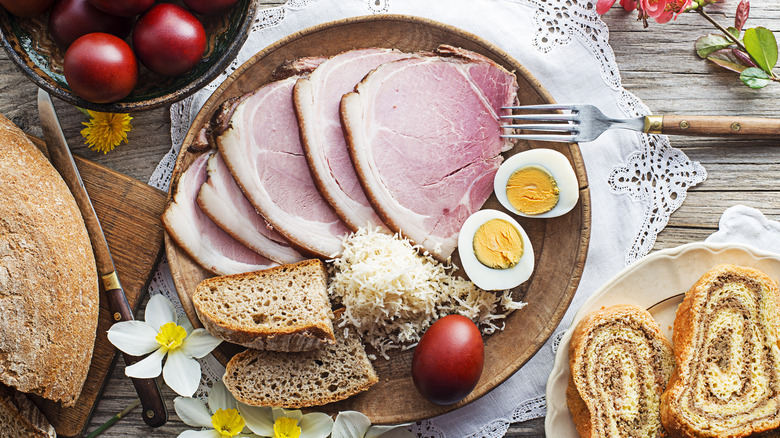What Part Of The Pig Is Ham Steak From?
As its name suggests, ham steaks are slices of meat, with or without a bone, from a ham. 'Ham' is a term for a cut of meat made up entirely of the pig's hindquarter, beginning at its hip joint and ending just before its back leg. Despite the joking label of 'the other white meat,' ham comes from a mammal and is therefore considered red meat.
As a cut, ham is divided into two parts: the rump and the shank. The rump is higher up on a pig and typically fattier. The shank is the lower part of the ham and is often tougher and less fatty. If you've ever purchased a cured ham, you are likely consuming the rump cut of the pig. Ham steaks, however, are most often cut from the shank — although they can be cut from the rump as well.
It is also important to know the difference between a pork and ham steak. Pork steaks are cut from the Boston butt, which is actually the front shoulder of a pig. Pork steaks typically have more fat, are smaller than a ham steak, and have a larger bone. So, while ham steaks are technically a 'pork' steak, the two cuts couldn't be more different.
Terminology of ham steak
The term 'ham steak' often confuses people because 'steak' is so often associated with a thick cut of beef. However, 'steak' simply refers to a thick slab of meat from any animal. You can have pork steaks, beef steaks, even venison or shark steaks. A steak just needs to be a flat, meaty cut to earn the name.
'Ham steak' is a natural progression of the terms 'ham' and 'steak' — given that it is a flat slice of meat cut from a pig's hindquarter. Ham steaks are even cooked similarly to beef steaks as they are both ideal for hot and fast cooking methods. And, like beef steaks, ham steaks can be purchased with or without the bone.
You can even have ham steak from other animals, such as deer. Yes, venison can have ham, which is not to be confused with the backstrap — the filet mignon of venison. Provided an animal yields a cut of meat referred to as a 'ham,' and that ham can be sliced into steaks, you've got ham steaks.
Additionally, both pork hams and ham steaks are most often purchased ready-to-eat. Whether they are cured, brined, or smoked, both cuts of meat can be consumed directly out of the package though they both benefit from some heating up before you enjoy them.
How to prepare a ham steak
Like many cuts of meat, how you prepare your ham steak boils down to its thickness. Unlike other cuts, the bone in a ham steak is so small that it doesn't need to be factored into your cooking. Regardless of how you prepare your ham steak, raw ham steaks should be cooked to a minimum internal temperature of 145 degrees Fahrenheit to prevent illness.
Thin-cut ham steaks are an ideal breakfast protein. Just throw one in a hot pan with some butter and salt, and you have a lean bacon alternative for your morning pork fix. This method is perfect for both raw and cured ham steaks — though raw ham steaks will require more time in the pan. Keep in mind that a ham steak's lower fat content will prevent it from crisping up the same way bacon will.
Thick-cut ham steaks should be treated like beef steaks — aiming to be cooked to at least medium-rare (that 145 Fahrenheit). Like beef steaks, and unlike pork chops, thick-cut ham steaks are not suited for an oven unless you're using a reverse searing method. Even then, the lack of fat in ham steaks and their thinness relative to beef steak means they are best prepared hot and fast — spending only a few minutes on each side over medium heat in a pan or on a grill.



